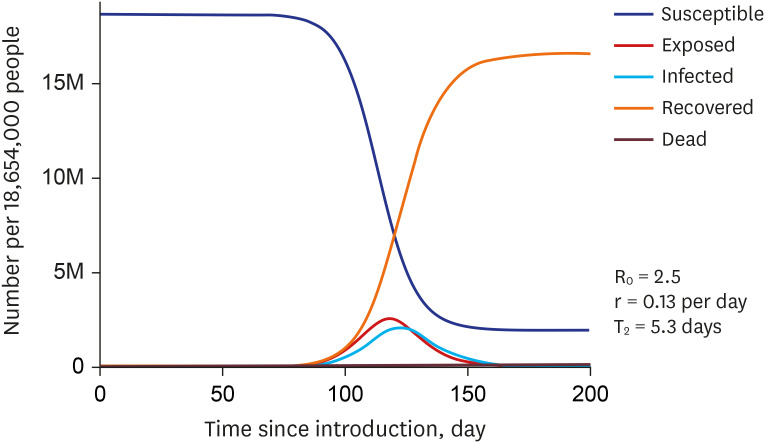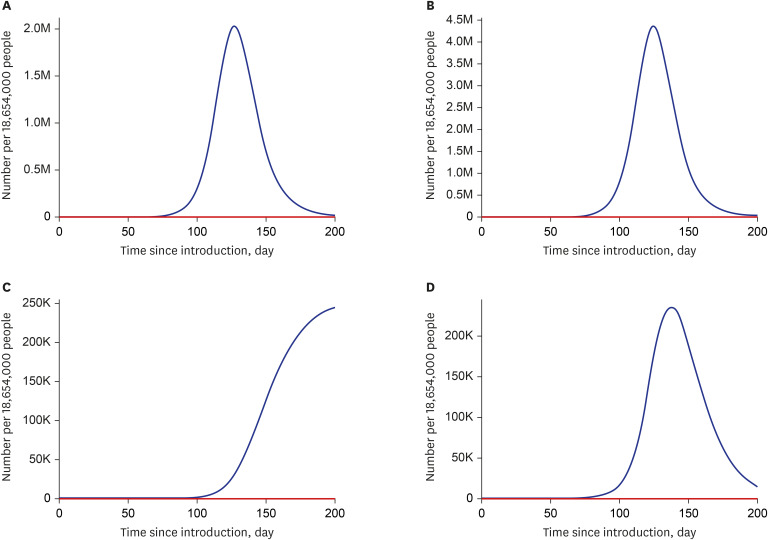J Korean Med Sci.
2020 Jun;35(24):e227. 10.3346/jkms.2020.35.e227.
Epidemiological Characteristics and Forecast of COVID-19 Outbreak in the Republic of Kazakhstan
- Affiliations
-
- 1Department of Neurology, Ophthalmology and Otolaryngology, Semey Medical University, Semey, Kazakhstan
- 2Department of Personalized Medicine, Semey Medical University, Semey, Kazakhstan
- 3Department of Internal Medicine, Semey Medical University, Semey, Kazakhstan
- 4Department of Public Health, Semey Medical University, Semey, Kazakhstan
- 5Head Office, Semey Medical University, Semey, Kazakhstan
- 6Head Office, Regional Oncology Hospital, Semey, Kazakhstan
- 7Postgraduate Department, Kazakh Medical University of Continuing Education, Almaty, Kazakhstan
- KMID: 2503018
- DOI: http://doi.org/10.3346/jkms.2020.35.e227
Abstract
- Background
Coronavirus disease 2019 (COVID-19) pandemic entered Kazakhstan on 13 March 2020 and quickly spread over its territory. This study aimed at reporting on the rates of COVID-19 in the country and at making prognoses on cases, deaths, and recoveries through predictive modeling. Also, we attempted to forecast the needs in professional workforce depending on implementation of quarantine measures.
Methods
We calculated both national and local incidence, mortality and case-fatality rates, and made forecast modeling via classic susceptible-exposed-infected-removed (SEIR) model. The Health Workforce Estimator tool was utilized for forecast modeling of health care workers capacity.
Results
The vast majority of symptomatic patients had mild disease manifestations and the proportion of moderate disease was around 10%. According to the SEIR model, there will be 156 thousand hospitalized patients due to severe illness and 15.47 thousand deaths at the peak of an outbreak if no measures are implemented. Besides, this will substantially increase the need in professional medical workforce. Still, 50% compliance with quarantine may possibly reduce the deaths up to 3.75 thousand cases and the number of hospitalized up to 9.31 thousand cases at the peak.
Conclusion
The outcomes of our study could be of interest for policymakers as they help to forecast the trends of COVID-19 outbreak, the demands for professional workforce, and to estimate the consequences of quarantine measures.
Keyword
Figure
Cited by 1 articles
-
Clinical Features of COVID-19 in Uzbekistan
KyungHee Kim, Jae Wook Choi, Juyoung Moon, Habibulla Akilov, Laziz Tuychiev, Bakhodir Rakhimov, Kwang Sung Min
J Korean Med Sci. 2020;35(45):e404. doi: 10.3346/jkms.2020.35.e404.
Reference
-
1. Lake MA. What we know so far: COVID-19 current clinical knowledge and research. Clin Med (Lond). 2020; 20(2):124–127. PMID: 32139372.
Article2. Lai CC, Shih TP, Ko WC, Tang HJ, Hsueh PR. Severe acute respiratory syndrome coronavirus 2 (SARS-CoV-2) and coronavirus disease-2019 (COVID-19): the epidemic and the challenges. Int J Antimicrob Agents. 2020; 55(3):105924. PMID: 32081636.
Article3. World Health Organization. WHO Director-General's opening remarks at the media briefing on COVID-19 (11 March 2020). Updated 2020. Accessed 2020 May 8. https://www.who.int/dg/speeches/detail/who-director-general-s-opening-remarks-at-the-media-briefing-on-covid-19---11-march-2020.4. Roser M, Ritchie H, Ortiz-Ospina E, Hasell J. Coronavirus (COVID-19) cases - statistics and research - our world in data. Updated 2020. Accessed 2020 May 8. https://ourworldindata.org/covid-cases.5. World Health Organization. Global Surveillance for human infection with coronavirus disease (COVID-19). Updated 2020. Accessed 2020 May 8. https://www.who.int/publications-detail/global-surveillance-for-human-infection-with-novel-coronavirus-(2019-ncov).6. Total COVID-19 tests per 1,000 people. Updated 2020. Accessed 2020 May 8. https://ourworldindata.org/grapher/full-list-cumulative-total-tests-per-thousand.7. Borges do Nascimento IJ, Cacic N, Abdulazeem HM, von Groote TC, Jayarajah U, Weerasekara I, et al. Novel coronavirus infection (COVID-19) in humans: a scoping review and meta-analysis. J Clin Med. 2020; 9(4):941.
Article8. The Novel Coronavirus Pneumonia Emergency Response Epidemiology Team. The epidemiological characteristics of an outbreak of 2019 novel coronavirus diseases (COVID-19) in China. China CDC Wkly. 2020; 2(8):113–122.9. European Center for Disease Prevention and Control. Coronavirus Disease 2019 (COVID-19) Pandemic: Increased Transmission in the EU/EEA and the UK: Seventh Update. Solna: European Center for Disease Prevention and Control;2020.10. Liu Y, Yang Y, Zhang C, Huang F, Wang F, Yuan J, et al. Clinical and biochemical indexes from 2019-nCoV infected patients linked to viral loads and lung injury. Sci China Life Sci. 2020; 63(3):364–374. PMID: 32048163.
Article11. World Health Organization. Infection prevention and control of epidemic- and pandemic-prone acute respiratory infections in health care. Updated 2014. Accessed 2020 May 8. www.who.int/about/licensing/copyright_form/en/index.html.12. Yen MY, Schwartz J, Chen SY, King CC, Yang GY, Hsueh PR. Interrupting COVID-19 transmission by implementing enhanced traffic control bundling: Implications for global prevention and control efforts. J Microbiol Immunol Infect. 2020; 53(3):377–380. PMID: 32205090.
Article13. Xu B, Gutierrez B, Mekaru S, Sewalk K, Goodwin L, Loskill A, et al. Epidemiological data from the COVID-19 outbreak, real-time case information. Sci Data. 2020; 7(1):106. PMID: 32210236.
Article14. National Center of Public Health. Kazakhstan. Accessed 2020 May 8. https://hls.kz/.15. Republican Center for Healthcare Development of the Ministry of Health of the Republic of Kazakhstan. Accessed 2020 May 8. http://www.rcrz.kz/index.php/en/.16. The World Bank Group. Kazakhstan data. Updated 2020. Accessed 2020 May 8. https://data.worldbank.org/country/kazakhstan.17. Gromova O, Doschanova A, Lokshin V, Tuletova A, Grebennikova G, Daniyarova L, et al. Vitamin D deficiency in Kazakhstan: cross-sectional study. J Steroid Biochem Mol Biol. 2020; 199:105565. PMID: 31812522.
Article18. Modeling COVID-19 spread vs healthcare capacity. Updated 2020. Accessed 2020 May 8. https://alhill.shinyapps.io/COVID19seir/.19. Rachah A, Torres DF. Analysis, simulation and optimal control of a seir model for ebola virus with demographic effects. Communications. 2018; 67(1):179–197.20. WHO Regional Office for Europe. Health workforce estimator. Updated 2020. Accessed 2020 May 8. https://euro.sharefile.com/share/view/s1df028894aa49abb/fob92ed8-23cb-4b24-a746-524bb6a27843.21. Wang L, Wang Y, Ye D, Liu Q. Review of the 2019 novel coronavirus (SARS-CoV-2) based on current evidence. Int J Antimicrob Agents. 2020; 55(6):105948. PMID: 32201353.
Article22. Peng L, Yang W, Zhang D, Zhuge C, Hong L. Epidemic analysis of COVID-19 in China by dynamical modeling. Updated 2020. Accessed 2020 May 8. http://arxiv.org/abs/2002.06563.23. Giordano G, Blanchini F, Bruno R, Colaneri P, Di Filippo A, Di Matteo A, et al. Modelling the COVID-19 epidemic and implementation of population-wide interventions in Italy. Nat Med. 2020; 1–6. PMID: 31932805.
Article25. Juneau CE, Pueyo T, Bell M, Gee G, Potvin L. Evidence-based, cost-effective interventions to suppress the COVID-19 pandemic: a rapid systematic review. Updated 2020. Accessed 2020 May 8. http://medrxiv.org/content/early/2020/04/24/2020.04.20.20054726.26. Brooks SK, Webster RK, Smith LE, Woodland L, Wessely S, Greenberg N, et al. The psychological impact of quarantine and how to reduce it: rapid review of the evidence. Lancet. 2020; 395(10227):912–920. PMID: 32112714.
Article27. Zou L, Ruan F, Huang M, Liang L, Huang H, Hong Z, et al. SARS-CoV-2 viral load in upper respiratory specimens of infected patients. N Engl J Med. 2020; 382(12):1177–1179. PMID: 32074444.
Article28. Chatterjee K, Chatterjee K, Kumar A, Shankar S. Healthcare impact of COVID-19 epidemic in India: a stochastic mathematical model. Med J Armed Forces India. 2020; 76(2):147–155.
Article29. Ruan Q, Yang K, Wang W, Jiang L, Song J. Clinical predictors of mortality due to COVID-19 based on an analysis of data of 150 patients from Wuhan, China. Intensive Care Med. 2020; 46:846–848. PMID: 32125452.
Article30. Shimabukuro-Vornhagen A, Gödel P, Subklewe M, Stemmler HJ, Schlößer HA, Schlaak M, et al. Cytokine release syndrome. J Immunother Cancer. 2018; 6(1):56. PMID: 29907163.
Article31. Siddiqi HK, Mehra MR. COVID-19 illness in native and immunosuppressed states: a clinical-therapeutic staging proposal. J Heart Lung Transplant. 2020; 39(5):405–407. PMID: 32362390.
Article32. Dauletyarova MA, Semenova YM, Kaylubaeva G, Manabaeva GK, Toktabayeva B, Zhelpakova MS, et al. Are Kazakhstani women satisfied with antenatal care? Implementing the WHO tool to assess the quality of antenatal services. Int J Environ Res Public Health. 2018; 15(2):325.
Article33. Dauletyarova M, Semenova Y, Kaylubaeva G, Manabaeva G, Khismetova Z, Akilzhanova Z, et al. Are women of East Kazakhstan satisfied with the quality of maternity care? Implementing the WHO tool to assess the quality of hospital services. Iran J Public Health. 2016; 45(6):729–738. PMID: 27648415.
- Full Text Links
- Actions
-
Cited
- CITED
-
- Close
- Share
- Similar articles
-
- Anticipating the Need for Healthcare Resources Following the Escalation of the COVID-19 Outbreak in the Republic of Kazakhstan
- Report on the Epidemiological Features of Coronavirus Disease 2019 (COVID-19) Outbreak in the Republic of Korea from January 19 to March 2, 2020
- Clinical and Epidemiological Characteristics of Coronavirus Disease 2019 in the Early Stage of Outbreak
- Cardiovascular Imaging Asia in the Era of the COVID-19 Outbreak
- Changes in Clinical Characteristics among Febrile Patients Visiting the Emergency Department before and after the COVID-19 Outbreak




